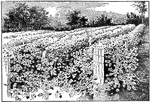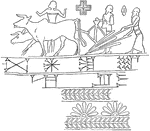
Branch of Lawson's Cypress
Also known as Chamaecyparis lawsoniana. Native to the southwest of Oregon to the far northwest of California.

Branch of Umbellularia Californica
A branch from an Umbellularia californica tree, native to the forests of California and Oregon.

Apple Orchard in Hood River Valley
Pictured is an apple orchard in Hood River Valley, Oregon. Apple growing is a big industry on the Pacific…

California Poppy
California poppy is a perennial that grows ten to twenty four inches high. The flowers are saucer shaped…

Loganberry Field
Illustrated is a field of loganberry as grown in Oregon. Extensive plantings are found all over western…

Babylonian Seal Impression
Pictured are men plowing a sowing. This illustration is from a Babylonian seal impression from the 14th…

Human Leg (Front View), and Comparative Diagrams showing Modifications of the Leg
This illustration shows a human leg (front view), and comparative diagrams showing modifications of…

Leg of Seal
This illustration shows the leg of a seal. P. Pelvis, FE. Femur, TI. Tibia, FI. Fibula, TA. Tarsus,…

Elephant Seal on a Rock
"The seal Macrorhinus elephantinus or proboscideus, or Morunga proboscidea. It is the largest of the…

Seal Swimming up to an Igloo
Illustration of the entrance of an igloo, built out of ice, partially underwater. A seal is swimming…

Leopard Seal
Leptonychotes weddelli. "A spotted seal of the southern and antarctic seas, belonging to the family…

Seal Press
"A press or stamp bearing dies on its jaws, or a die and a bed, for imprinting or embossing any device…

Skippet - Open Box with a Seal Inside
"A circular box used for covering and protecting a seal. Old documents were commonly sealed by means…
